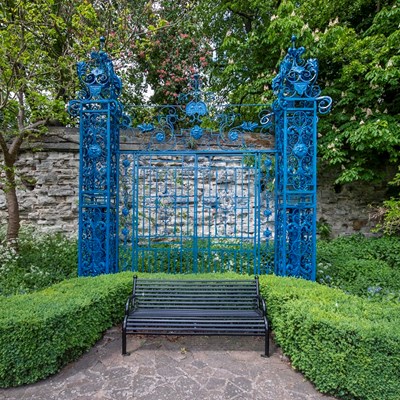TWO important examples of Leicester’s architectural history have been fully restored thanks to a grant for expert repair work.
Leicester was awarded a total of £27,500 of support from the Heritage Stimulus Fund, part of the Government’s Culture Recovery Fund administered by Historic England.
Leicester City Council successfully bid for £20,000 to help restore the Grade II*-listed Quenby Hall Gates, which currently stand in the gardens of Newarke Houses Museum.
Alongside this, the Leicester Unitarians were awarded £5,000 to help fund repairs to the boundary wall of the city’s historic Great Meeting Chapel.
Work on both projects is now complete.
The highly decorative, wrought iron Quenby Hall gates, which date back to the early 18th century have received extensive expert repairs and restoration by East Midlands-based specialists Calibre Conservation.
The work has seen parts of the existing metalwork repaired, missing sections reinstated and poor-quality replicas of decorative details carefully swapped out for specially cast and historically accurate replacements.
One of the most striking changes resulting from the restoration is the gates are now painted a bold Prussian blue, rather than the black finish that visitors to Newarke Houses Museum will have been familiar with. This is a result of expert paint analysis by the conservation contractors and more closely reflects how the gates would have originally been painted. The Prussian blue pigment was still a relatively new discovery in the early 1700s and was considered prestigious at the time. It also links to the colours of the crest of George Ashby – owner of the Quenby Hall estate – which features heavily in the design of the historic gates.
The gates were originally located at Quenby Hall, near Cold Newton and Hungarton, in Leicestershire. They were donated to the Leicester Royal Infirmary in 1768, following a redesign of the hall’s gardens, and remained on the hospital grounds until the building of the extension to the Victoria Wing in 1901. They were then relocated to new Walk Museum in 1902, before being moved to their current home in 1955. Work is ongoing on a longer-term plan that could see the fully restored historic gates returned to the hospital site as the centrepiece of a new garden space.
Repairs have also been carried out to the historic boundary wall to the Great Meeting Chapel on Butt Close Lane. The Grade-II listed, 18th century red brick wall has been professionally repaired and repointed with missing brickwork carefully replaced. The work was part-funded by a further grant from the city council’s Historic Buildings Grant scheme. The works form part of a larger ongoing project to restore the Great Meeting Chapel, one of the most interesting Georgian sites in the city.
Deputy city mayor and city council heritage champion Cllr Adam Clarke, said: “The support from the Culture Recovery Fund has helped ensure that we can enhance and protect two more important examples of the city’s rich architectural heritage. I am delighted that these two fascinating examples have benefitted from such well researched, sensitive and painstaking restoration which will help ensure they can be enjoyed by future generations.”
Chairman of the Great Meeting Chapel, Mike Drucquer, said: "Restoration of the historic boundary wall has proved to be of great interest to groups and individuals who visit the chapel. It has also revealed that the wall is made up of a fascinating mix of materials from different eras which provide unique insights into Leicester's history.”
Both structures were previously in a poor condition and were included in the most recent Leicester Heritage at Risk Register. It is expected that the restoration will result in their removal from the list. This will bring the total number of historic buildings and structures removed from the local list over the last five years to 33.
Grants from the government’s £1.57 billion Culture Recovery Fund were intended to protect heritage sites and ensure that jobs and access to culture and heritage in local communities were protected during the coronavirus pandemic.
Duncan Wilson, Historic England Chief Executive said: [DRAFT] “The Culture recovery Fund offered a lifeline to kickstart essential repairs and maintenance at many of our most precious historic sites, so they could begin to recover from the damaging effects of Covid-19.
“It helped provide employment for skilled craft workers who help keep historic places alive and the wheels of the heritage sector turning. Our shared heritage is an anchor for us all in difficult times and this funding has helped ensure it will remain part of our collective future.”
